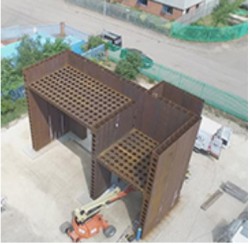New generation NPP manufacturers have been developing modular construction techniques that make greater use of pre-fabrication and factory assembly and reduce reliance on site activity. Most have adopted a technique that uses composite steel/concrete (SC) modules made by pouring concrete between two steel plates. The plates serve the dual purpose of reinforcement and permanent formwork to the concrete. Shear studs welded to the inside surfaces of the plates ensure composite action between the steel and concrete and can be spaced such that the compression steel plates do not buckle under load. They also provide the means for easy attachment of support points for equipment, eliminating the need for embedded steel plates or concrete expansion anchors.
To support the surface plates during assembly, lifting, transportation, concrete pouring and curing, the two plates must be connected together to form a self-supporting unit. In this way, parts of modules may be fabricated off-site and transported as units to be assembled on-site and connected together. Many attempts have been made over the past 25 years to devise practical, economic and safe methods of connecting the plates. SCI has been working with SCI Member Caunton Engineering in a project funded by Innovate UK to design and construct a new generation of SC modular construction (‘Steel Bricks’) that overcomes the manufacturing problems of earlier SC systems. A Steel Brick is made by cutting a pattern into a flat steel plate and then folding the plate to form an ‘L’ shape. Shear studs are welded to the sides of the ‘L’ section and then two ‘L’ shaped plates are welded to form a ‘U’ shape. The circular holes in the base of the ‘U’ allow concrete to flow between bricks joined side-by-side and Steel Bricks can be welded together to create large structural modules. The base of the ‘U’, which is integral to the Steel Brick, provides the means of holding the two sides of the panel together and acts as out-of-plane shear reinforcement to the concrete.
Following completion of several workshop and field trials, a full scale structure (part of a diesel generator building on a nuclear power plant site) has been constructed to demonstrate the buildability of the system.
A full paper demonstrating the research findings is available at ICE as part of their ICE Proceedings.
Original link – Steel Construction Institute









